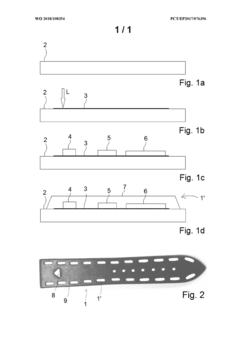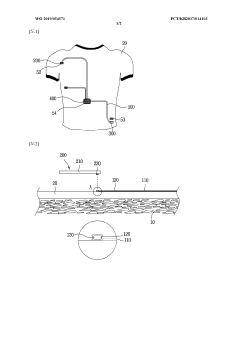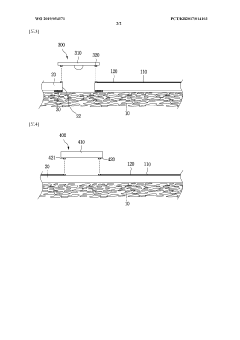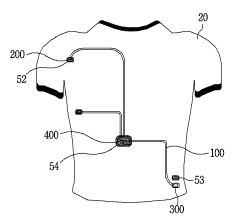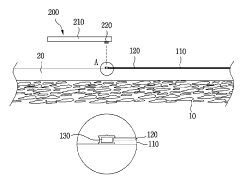How to Integrate Polycarbonate into Smart Wearables?
JUL 1, 20259 MIN READ
Generate Your Research Report Instantly with AI Agent
Patsnap Eureka helps you evaluate technical feasibility & market potential.
Polycarbonate Integration Goals
The integration of polycarbonate into smart wearables represents a significant technological advancement in the wearable technology sector. The primary goal is to leverage polycarbonate's unique properties to enhance the functionality, durability, and user experience of smart wearable devices. This integration aims to address several key objectives in the development of next-generation wearables.
One of the primary goals is to improve the overall durability and longevity of smart wearable devices. Polycarbonate, known for its high impact resistance and toughness, can significantly enhance the device's ability to withstand daily wear and tear, accidental drops, and exposure to various environmental conditions. This increased durability is crucial for wearables that are constantly exposed to potential damage during everyday use.
Another important objective is to reduce the weight of smart wearables while maintaining structural integrity. Polycarbonate's low density compared to other materials traditionally used in wearables, such as metals, allows for the creation of lighter devices. This weight reduction is essential for improving user comfort, especially for devices worn for extended periods.
The integration of polycarbonate also aims to enhance the design flexibility of smart wearables. The material's moldability and versatility in manufacturing processes enable the creation of more complex and ergonomic designs. This flexibility allows for the development of wearables that better conform to the human body, improving both aesthetics and functionality.
Improving the thermal management of smart wearables is another crucial goal. Polycarbonate's low thermal conductivity can help in creating devices that are more comfortable to wear, especially in devices that generate heat during operation. This property is particularly important for wearables that are in direct contact with the skin for long periods.
Furthermore, the integration of polycarbonate seeks to enhance the optical properties of smart wearables. The material's transparency and ability to be tinted or coated make it ideal for creating display windows, lenses, or light-guiding components in wearable devices. This can lead to improved display quality and functionality in devices like smart glasses or augmented reality headsets.
Lastly, the goal of integrating polycarbonate into smart wearables includes improving the devices' resistance to various environmental factors. This includes enhancing water resistance, UV stability, and chemical resistance, which are crucial for wearables used in diverse conditions and environments. The material's inherent properties and potential for surface treatments contribute to achieving these protective characteristics.
One of the primary goals is to improve the overall durability and longevity of smart wearable devices. Polycarbonate, known for its high impact resistance and toughness, can significantly enhance the device's ability to withstand daily wear and tear, accidental drops, and exposure to various environmental conditions. This increased durability is crucial for wearables that are constantly exposed to potential damage during everyday use.
Another important objective is to reduce the weight of smart wearables while maintaining structural integrity. Polycarbonate's low density compared to other materials traditionally used in wearables, such as metals, allows for the creation of lighter devices. This weight reduction is essential for improving user comfort, especially for devices worn for extended periods.
The integration of polycarbonate also aims to enhance the design flexibility of smart wearables. The material's moldability and versatility in manufacturing processes enable the creation of more complex and ergonomic designs. This flexibility allows for the development of wearables that better conform to the human body, improving both aesthetics and functionality.
Improving the thermal management of smart wearables is another crucial goal. Polycarbonate's low thermal conductivity can help in creating devices that are more comfortable to wear, especially in devices that generate heat during operation. This property is particularly important for wearables that are in direct contact with the skin for long periods.
Furthermore, the integration of polycarbonate seeks to enhance the optical properties of smart wearables. The material's transparency and ability to be tinted or coated make it ideal for creating display windows, lenses, or light-guiding components in wearable devices. This can lead to improved display quality and functionality in devices like smart glasses or augmented reality headsets.
Lastly, the goal of integrating polycarbonate into smart wearables includes improving the devices' resistance to various environmental factors. This includes enhancing water resistance, UV stability, and chemical resistance, which are crucial for wearables used in diverse conditions and environments. The material's inherent properties and potential for surface treatments contribute to achieving these protective characteristics.
Smart Wearables Market Analysis
The smart wearables market has experienced significant growth in recent years, driven by advancements in technology, increasing health consciousness, and the growing demand for connected devices. This market encompasses a wide range of products, including smartwatches, fitness trackers, smart glasses, and health monitoring devices. The global smart wearables market size was valued at approximately $27 billion in 2019 and is projected to reach $64 billion by 2024, growing at a CAGR of 19.5% during the forecast period.
The integration of polycarbonate into smart wearables presents a significant opportunity for market expansion and product innovation. Polycarbonate, known for its durability, lightweight properties, and versatility, aligns well with the requirements of smart wearable devices. As consumers demand more robust and long-lasting wearables, polycarbonate's impact resistance and flexibility make it an attractive material choice for manufacturers.
Key market drivers for smart wearables include the rising adoption of IoT and connected devices, increasing health awareness, and the growing fitness trend among consumers. The COVID-19 pandemic has further accelerated the demand for health monitoring devices, with a surge in interest for wearables that can track vital signs and potential symptoms. This trend is expected to continue, creating new opportunities for polycarbonate integration in medical-grade wearables.
The smartwatch segment dominates the smart wearables market, accounting for the largest market share. Major players like Apple, Samsung, and Fitbit continue to innovate in this space, with potential for polycarbonate integration in watch cases, bands, and internal components. The fitness tracker segment is also showing strong growth, particularly in emerging markets where affordability is a key factor. Polycarbonate's cost-effectiveness could play a crucial role in expanding this market segment.
Geographically, North America leads the smart wearables market, followed by Europe and Asia-Pacific. However, the Asia-Pacific region is expected to witness the highest growth rate in the coming years, driven by increasing disposable income, technological advancements, and a large consumer base. This regional growth presents significant opportunities for polycarbonate integration, especially in markets where cost-effective yet durable solutions are in high demand.
The enterprise and industrial sectors are emerging as promising areas for smart wearables adoption, with applications in workforce safety, productivity monitoring, and remote assistance. Polycarbonate's durability and chemical resistance make it well-suited for these more demanding environments, potentially opening new market segments for integrated polycarbonate smart wearables.
The integration of polycarbonate into smart wearables presents a significant opportunity for market expansion and product innovation. Polycarbonate, known for its durability, lightweight properties, and versatility, aligns well with the requirements of smart wearable devices. As consumers demand more robust and long-lasting wearables, polycarbonate's impact resistance and flexibility make it an attractive material choice for manufacturers.
Key market drivers for smart wearables include the rising adoption of IoT and connected devices, increasing health awareness, and the growing fitness trend among consumers. The COVID-19 pandemic has further accelerated the demand for health monitoring devices, with a surge in interest for wearables that can track vital signs and potential symptoms. This trend is expected to continue, creating new opportunities for polycarbonate integration in medical-grade wearables.
The smartwatch segment dominates the smart wearables market, accounting for the largest market share. Major players like Apple, Samsung, and Fitbit continue to innovate in this space, with potential for polycarbonate integration in watch cases, bands, and internal components. The fitness tracker segment is also showing strong growth, particularly in emerging markets where affordability is a key factor. Polycarbonate's cost-effectiveness could play a crucial role in expanding this market segment.
Geographically, North America leads the smart wearables market, followed by Europe and Asia-Pacific. However, the Asia-Pacific region is expected to witness the highest growth rate in the coming years, driven by increasing disposable income, technological advancements, and a large consumer base. This regional growth presents significant opportunities for polycarbonate integration, especially in markets where cost-effective yet durable solutions are in high demand.
The enterprise and industrial sectors are emerging as promising areas for smart wearables adoption, with applications in workforce safety, productivity monitoring, and remote assistance. Polycarbonate's durability and chemical resistance make it well-suited for these more demanding environments, potentially opening new market segments for integrated polycarbonate smart wearables.
Polycarbonate Properties and Challenges
Polycarbonate, a versatile thermoplastic polymer, possesses a unique combination of properties that make it an attractive material for smart wearable devices. Its high impact strength, optical clarity, and thermal stability contribute to its widespread use in various industries, including electronics and medical devices. However, integrating polycarbonate into smart wearables presents several challenges that must be addressed to fully leverage its potential.
One of the primary advantages of polycarbonate is its exceptional impact resistance, which is crucial for wearable devices that may be subjected to daily wear and tear. This property ensures that smart wearables can withstand accidental drops or impacts without compromising their functionality or structural integrity. Additionally, polycarbonate's optical clarity allows for the integration of transparent components, such as display screens or sensor windows, without sacrificing visual quality.
The material's low weight and high strength-to-weight ratio make it ideal for creating lightweight yet durable wearable devices. This characteristic is particularly important for user comfort, as heavier devices can lead to fatigue during prolonged use. Polycarbonate's thermal stability also contributes to its suitability for smart wearables, as it can maintain its properties across a wide range of temperatures, ensuring consistent performance in various environmental conditions.
Despite these advantages, several challenges must be overcome when integrating polycarbonate into smart wearables. One significant issue is the material's limited chemical resistance, which can make it susceptible to degradation when exposed to certain solvents or chemicals. This vulnerability necessitates careful consideration of the device's intended use and potential exposure to harmful substances.
Another challenge lies in polycarbonate's relatively low scratch resistance compared to some other materials used in wearable devices. This limitation can affect the longevity and aesthetic appeal of smart wearables, particularly for devices with exposed surfaces. Addressing this issue may require the application of specialized coatings or surface treatments to enhance scratch resistance without compromising other desirable properties.
The integration of electronic components into polycarbonate structures presents additional challenges. While polycarbonate is an electrical insulator, which can be advantageous for certain applications, it may require modification or the use of conductive additives to accommodate specific electronic functionalities. Furthermore, the material's thermal insulation properties can pose challenges in heat dissipation, potentially affecting the performance of heat-generating components in smart wearables.
Manufacturability is another crucial aspect to consider when working with polycarbonate in smart wearables. While the material is generally amenable to various manufacturing processes, including injection molding and thermoforming, achieving precise tolerances and intricate designs may require specialized techniques or equipment. Additionally, ensuring proper adhesion between polycarbonate components and other materials used in smart wearables, such as metals or elastomers, can be challenging and may necessitate the use of specific bonding agents or surface treatments.
One of the primary advantages of polycarbonate is its exceptional impact resistance, which is crucial for wearable devices that may be subjected to daily wear and tear. This property ensures that smart wearables can withstand accidental drops or impacts without compromising their functionality or structural integrity. Additionally, polycarbonate's optical clarity allows for the integration of transparent components, such as display screens or sensor windows, without sacrificing visual quality.
The material's low weight and high strength-to-weight ratio make it ideal for creating lightweight yet durable wearable devices. This characteristic is particularly important for user comfort, as heavier devices can lead to fatigue during prolonged use. Polycarbonate's thermal stability also contributes to its suitability for smart wearables, as it can maintain its properties across a wide range of temperatures, ensuring consistent performance in various environmental conditions.
Despite these advantages, several challenges must be overcome when integrating polycarbonate into smart wearables. One significant issue is the material's limited chemical resistance, which can make it susceptible to degradation when exposed to certain solvents or chemicals. This vulnerability necessitates careful consideration of the device's intended use and potential exposure to harmful substances.
Another challenge lies in polycarbonate's relatively low scratch resistance compared to some other materials used in wearable devices. This limitation can affect the longevity and aesthetic appeal of smart wearables, particularly for devices with exposed surfaces. Addressing this issue may require the application of specialized coatings or surface treatments to enhance scratch resistance without compromising other desirable properties.
The integration of electronic components into polycarbonate structures presents additional challenges. While polycarbonate is an electrical insulator, which can be advantageous for certain applications, it may require modification or the use of conductive additives to accommodate specific electronic functionalities. Furthermore, the material's thermal insulation properties can pose challenges in heat dissipation, potentially affecting the performance of heat-generating components in smart wearables.
Manufacturability is another crucial aspect to consider when working with polycarbonate in smart wearables. While the material is generally amenable to various manufacturing processes, including injection molding and thermoforming, achieving precise tolerances and intricate designs may require specialized techniques or equipment. Additionally, ensuring proper adhesion between polycarbonate components and other materials used in smart wearables, such as metals or elastomers, can be challenging and may necessitate the use of specific bonding agents or surface treatments.
Current Polycarbonate Integration Methods
01 Synthesis and modification of polycarbonates
Various methods for synthesizing and modifying polycarbonates are explored, including new catalysts, reaction conditions, and additives to improve properties such as molecular weight, thermal stability, and optical clarity. These techniques aim to enhance the overall performance and versatility of polycarbonate materials for different applications.- Synthesis and modification of polycarbonates: Various methods for synthesizing and modifying polycarbonates are explored, including new catalysts, reaction conditions, and additives to improve properties such as molecular weight, thermal stability, and optical clarity. These techniques aim to enhance the performance and versatility of polycarbonate materials for different applications.
- Polycarbonate blends and composites: Development of polycarbonate blends and composites with other polymers or additives to achieve improved mechanical properties, flame retardancy, or specific functionalities. These formulations expand the range of applications for polycarbonate-based materials in various industries.
- Polycarbonate processing techniques: Advancements in processing techniques for polycarbonates, including extrusion, injection molding, and film formation. These methods focus on improving production efficiency, reducing defects, and enhancing the final product quality for applications in electronics, automotive, and consumer goods.
- Polycarbonate surface treatments and coatings: Innovations in surface treatments and coatings for polycarbonate materials to enhance properties such as scratch resistance, UV stability, and anti-fogging capabilities. These treatments extend the durability and functionality of polycarbonate products in various environments.
- Recycling and sustainability of polycarbonates: Development of methods for recycling polycarbonate materials and improving their sustainability. This includes techniques for chemical depolymerization, mechanical recycling, and the incorporation of recycled content into new polycarbonate products to reduce environmental impact.
02 Polycarbonate blends and composites
Development of polycarbonate blends and composites with other polymers or additives to achieve improved mechanical, thermal, and chemical properties. These formulations can include flame retardants, impact modifiers, or other functional materials to tailor the polycarbonate for specific end-use requirements.Expand Specific Solutions03 Polycarbonate processing and manufacturing
Advancements in processing techniques and manufacturing methods for polycarbonate products, including extrusion, injection molding, and film formation. These innovations focus on improving production efficiency, reducing defects, and enhancing the quality of final polycarbonate products.Expand Specific Solutions04 Polycarbonate applications in electronics
Utilization of polycarbonates in electronic devices and components, such as housings, displays, and insulating materials. This includes developments in flame-retardant polycarbonate formulations, transparent conductive films, and heat-resistant grades for various electronic applications.Expand Specific Solutions05 Recycling and sustainability of polycarbonates
Methods for recycling polycarbonate materials and developing more sustainable production processes. This includes chemical recycling techniques, bio-based polycarbonate alternatives, and strategies to reduce the environmental impact of polycarbonate manufacturing and disposal.Expand Specific Solutions
Key Players in Polycarbonate Wearables
The integration of polycarbonate into smart wearables is at a nascent stage, with the market showing significant growth potential. The technology is evolving rapidly, driven by increasing demand for durable, lightweight, and flexible materials in wearable devices. Key players like SABIC, Covestro, and Wanhua Chemical are leading the innovation in this field, developing advanced polycarbonate formulations tailored for wearable applications. Companies such as Intel, GoerTek, and Senbiosys are exploring ways to incorporate these materials into their smart wearable designs, focusing on improving device performance, comfort, and durability. As the technology matures, we can expect to see more widespread adoption across various wearable product categories.
SABIC Global Technologies BV
Technical Solution: SABIC has developed a range of polycarbonate materials specifically designed for smart wearables. Their LEXAN™ polycarbonate resins offer a combination of durability, lightweight properties, and design flexibility[1]. The company has introduced flame-retardant grades that meet UL94 V-0 standards at thin wall sections, crucial for compact wearable devices[2]. SABIC's polycarbonate solutions also feature high-flow grades that enable intricate designs and thin-wall molding, essential for miniaturized wearable components[3]. Additionally, they have developed polycarbonate blends with enhanced chemical resistance to withstand exposure to skin oils and cosmetics, ensuring longevity of wearable devices[4].
Strengths: Extensive experience in polycarbonate technology, wide range of specialized grades for wearables, strong focus on durability and safety. Weaknesses: May face competition from newer, more specialized materials in certain niche applications.
GoerTek Inc.
Technical Solution: GoerTek has integrated polycarbonate into their smart wearable designs, focusing on acoustic components and hearables. They utilize polycarbonate's excellent sound transmission properties to create high-quality audio experiences in compact wearable devices[1]. The company has developed proprietary molding techniques that allow for the production of ultra-thin polycarbonate housings for earbuds and hearing aids, maximizing internal space for electronics while maintaining structural integrity[2]. GoerTek has also implemented a multi-material approach, combining polycarbonate with other polymers to achieve optimal performance in areas such as impact resistance and comfort for long-term wear[3].
Strengths: Specialized expertise in acoustic applications of polycarbonate, advanced manufacturing techniques for miniaturization. Weaknesses: Focus primarily on audio wearables may limit broader application in other wearable categories.
Innovative Polycarbonate Applications
Method for producing a smart bracelet provided with an insert for electronic components
PatentWO2018108354A1
Innovation
- A method for producing a smart bracelet with a plastronic insert comprising a flexible plastic support for electronic components, which includes selective metallization and a protective elastomeric layer, ensuring protection against environmental conditions while maintaining a low thickness, allowing integration within traditional leather or synthetic material linings.
Smart garment integrated with wire coated with conductive silicone rubber
PatentWO2019054571A1
Innovation
- The integration of wires coated with elastic conductive silicone rubber allows for easy attachment and detachment of sensors and devices, with electrically conductive Velcro or metal snap buttons, and a breathable cover for durability and flexibility, enabling real-time biometric data collection during activities.
Environmental Impact Assessment
The integration of polycarbonate into smart wearables presents both opportunities and challenges from an environmental perspective. Polycarbonate, a versatile thermoplastic polymer, offers durability and flexibility, making it an attractive material for wearable devices. However, its production and disposal processes raise significant environmental concerns that must be carefully considered.
The manufacturing of polycarbonate involves energy-intensive processes and the use of potentially harmful chemicals, including bisphenol A (BPA). These factors contribute to increased carbon emissions and potential environmental contamination. As smart wearables gain popularity, the demand for polycarbonate is likely to rise, potentially exacerbating these environmental impacts if not properly managed.
On the positive side, the durability of polycarbonate can lead to longer-lasting products, potentially reducing electronic waste. Smart wearables made with polycarbonate may have extended lifespans compared to those made with less durable materials, which could help mitigate the growing problem of e-waste in landfills.
However, the end-of-life disposal of polycarbonate-based wearables poses significant challenges. While polycarbonate is technically recyclable, the complex integration with other materials in smart devices often makes recycling difficult and economically unfeasible. This can result in increased waste accumulation and potential environmental pollution if not properly addressed.
The use of polycarbonate in smart wearables also raises concerns about microplastic pollution. As these devices wear over time, they may release microscopic plastic particles into the environment, contributing to the growing problem of microplastic contamination in ecosystems.
To mitigate these environmental impacts, several strategies can be employed. Manufacturers should focus on developing more sustainable production methods for polycarbonate, such as using renewable energy sources and exploring bio-based alternatives. Additionally, designing smart wearables for easy disassembly and material separation can greatly improve their recyclability at the end of their lifecycle.
Implementing take-back programs and promoting circular economy principles can help ensure that polycarbonate-based wearables are properly collected and recycled. This approach not only reduces waste but also conserves resources by allowing the recovery and reuse of valuable materials.
In conclusion, while polycarbonate offers valuable properties for smart wearables, its integration must be approached with careful consideration of environmental impacts. Balancing the benefits of durability and functionality with sustainable production and disposal methods will be crucial in minimizing the ecological footprint of these innovative devices.
The manufacturing of polycarbonate involves energy-intensive processes and the use of potentially harmful chemicals, including bisphenol A (BPA). These factors contribute to increased carbon emissions and potential environmental contamination. As smart wearables gain popularity, the demand for polycarbonate is likely to rise, potentially exacerbating these environmental impacts if not properly managed.
On the positive side, the durability of polycarbonate can lead to longer-lasting products, potentially reducing electronic waste. Smart wearables made with polycarbonate may have extended lifespans compared to those made with less durable materials, which could help mitigate the growing problem of e-waste in landfills.
However, the end-of-life disposal of polycarbonate-based wearables poses significant challenges. While polycarbonate is technically recyclable, the complex integration with other materials in smart devices often makes recycling difficult and economically unfeasible. This can result in increased waste accumulation and potential environmental pollution if not properly addressed.
The use of polycarbonate in smart wearables also raises concerns about microplastic pollution. As these devices wear over time, they may release microscopic plastic particles into the environment, contributing to the growing problem of microplastic contamination in ecosystems.
To mitigate these environmental impacts, several strategies can be employed. Manufacturers should focus on developing more sustainable production methods for polycarbonate, such as using renewable energy sources and exploring bio-based alternatives. Additionally, designing smart wearables for easy disassembly and material separation can greatly improve their recyclability at the end of their lifecycle.
Implementing take-back programs and promoting circular economy principles can help ensure that polycarbonate-based wearables are properly collected and recycled. This approach not only reduces waste but also conserves resources by allowing the recovery and reuse of valuable materials.
In conclusion, while polycarbonate offers valuable properties for smart wearables, its integration must be approached with careful consideration of environmental impacts. Balancing the benefits of durability and functionality with sustainable production and disposal methods will be crucial in minimizing the ecological footprint of these innovative devices.
Durability and Longevity Analysis
The integration of polycarbonate into smart wearables necessitates a thorough analysis of its durability and longevity characteristics. Polycarbonate, known for its high impact resistance and optical clarity, offers significant advantages in the wearable technology sector. However, its long-term performance under various environmental conditions and user interactions requires careful examination.
One of the primary considerations in durability analysis is the material's resistance to scratches and abrasions. Smart wearables are subjected to constant physical contact and potential impacts during daily use. Polycarbonate's inherent toughness provides a good foundation, but surface treatments or coatings may be necessary to enhance scratch resistance further. These treatments must be evaluated for their effectiveness and longevity, ensuring they do not compromise the material's other properties.
Environmental factors play a crucial role in the longevity of polycarbonate-based wearables. Exposure to UV radiation, temperature fluctuations, and humidity can potentially degrade the material over time. Accelerated aging tests simulating these conditions are essential to predict the long-term performance of polycarbonate in various climates and usage scenarios. The results of these tests can inform design decisions and material modifications to improve overall durability.
Chemical resistance is another vital aspect of durability analysis for smart wearables. Polycarbonate's interaction with common substances such as sweat, cosmetics, and cleaning agents must be thoroughly investigated. While polycarbonate generally exhibits good chemical resistance, prolonged exposure to certain compounds may lead to stress cracking or discoloration. Identifying potential vulnerabilities and developing appropriate protective measures or material formulations is crucial for ensuring the longevity of the wearable device.
The mechanical properties of polycarbonate over time are also of significant interest. Repeated stress and strain from daily wear can potentially lead to fatigue or creep in the material. Analyzing the long-term mechanical behavior of polycarbonate under various load conditions typical in wearable applications is essential. This analysis should include considerations for different design geometries and attachment methods used in smart wearables.
Thermal management is a critical factor in the durability of smart wearables, particularly those with integrated electronics. Polycarbonate's thermal properties and its ability to dissipate heat generated by electronic components must be carefully evaluated. Long-term exposure to elevated temperatures can affect the material's mechanical properties and dimensional stability. Thermal cycling tests and heat dissipation studies are necessary to ensure the polycarbonate structure maintains its integrity throughout the device's intended lifespan.
In conclusion, a comprehensive durability and longevity analysis of polycarbonate in smart wearables involves a multifaceted approach. It requires consideration of physical, chemical, and environmental factors that may impact the material's performance over time. By thoroughly examining these aspects, manufacturers can optimize the integration of polycarbonate into smart wearables, ensuring products that are not only functional and aesthetically pleasing but also durable and long-lasting.
One of the primary considerations in durability analysis is the material's resistance to scratches and abrasions. Smart wearables are subjected to constant physical contact and potential impacts during daily use. Polycarbonate's inherent toughness provides a good foundation, but surface treatments or coatings may be necessary to enhance scratch resistance further. These treatments must be evaluated for their effectiveness and longevity, ensuring they do not compromise the material's other properties.
Environmental factors play a crucial role in the longevity of polycarbonate-based wearables. Exposure to UV radiation, temperature fluctuations, and humidity can potentially degrade the material over time. Accelerated aging tests simulating these conditions are essential to predict the long-term performance of polycarbonate in various climates and usage scenarios. The results of these tests can inform design decisions and material modifications to improve overall durability.
Chemical resistance is another vital aspect of durability analysis for smart wearables. Polycarbonate's interaction with common substances such as sweat, cosmetics, and cleaning agents must be thoroughly investigated. While polycarbonate generally exhibits good chemical resistance, prolonged exposure to certain compounds may lead to stress cracking or discoloration. Identifying potential vulnerabilities and developing appropriate protective measures or material formulations is crucial for ensuring the longevity of the wearable device.
The mechanical properties of polycarbonate over time are also of significant interest. Repeated stress and strain from daily wear can potentially lead to fatigue or creep in the material. Analyzing the long-term mechanical behavior of polycarbonate under various load conditions typical in wearable applications is essential. This analysis should include considerations for different design geometries and attachment methods used in smart wearables.
Thermal management is a critical factor in the durability of smart wearables, particularly those with integrated electronics. Polycarbonate's thermal properties and its ability to dissipate heat generated by electronic components must be carefully evaluated. Long-term exposure to elevated temperatures can affect the material's mechanical properties and dimensional stability. Thermal cycling tests and heat dissipation studies are necessary to ensure the polycarbonate structure maintains its integrity throughout the device's intended lifespan.
In conclusion, a comprehensive durability and longevity analysis of polycarbonate in smart wearables involves a multifaceted approach. It requires consideration of physical, chemical, and environmental factors that may impact the material's performance over time. By thoroughly examining these aspects, manufacturers can optimize the integration of polycarbonate into smart wearables, ensuring products that are not only functional and aesthetically pleasing but also durable and long-lasting.
Unlock deeper insights with Patsnap Eureka Quick Research — get a full tech report to explore trends and direct your research. Try now!
Generate Your Research Report Instantly with AI Agent
Supercharge your innovation with Patsnap Eureka AI Agent Platform!
